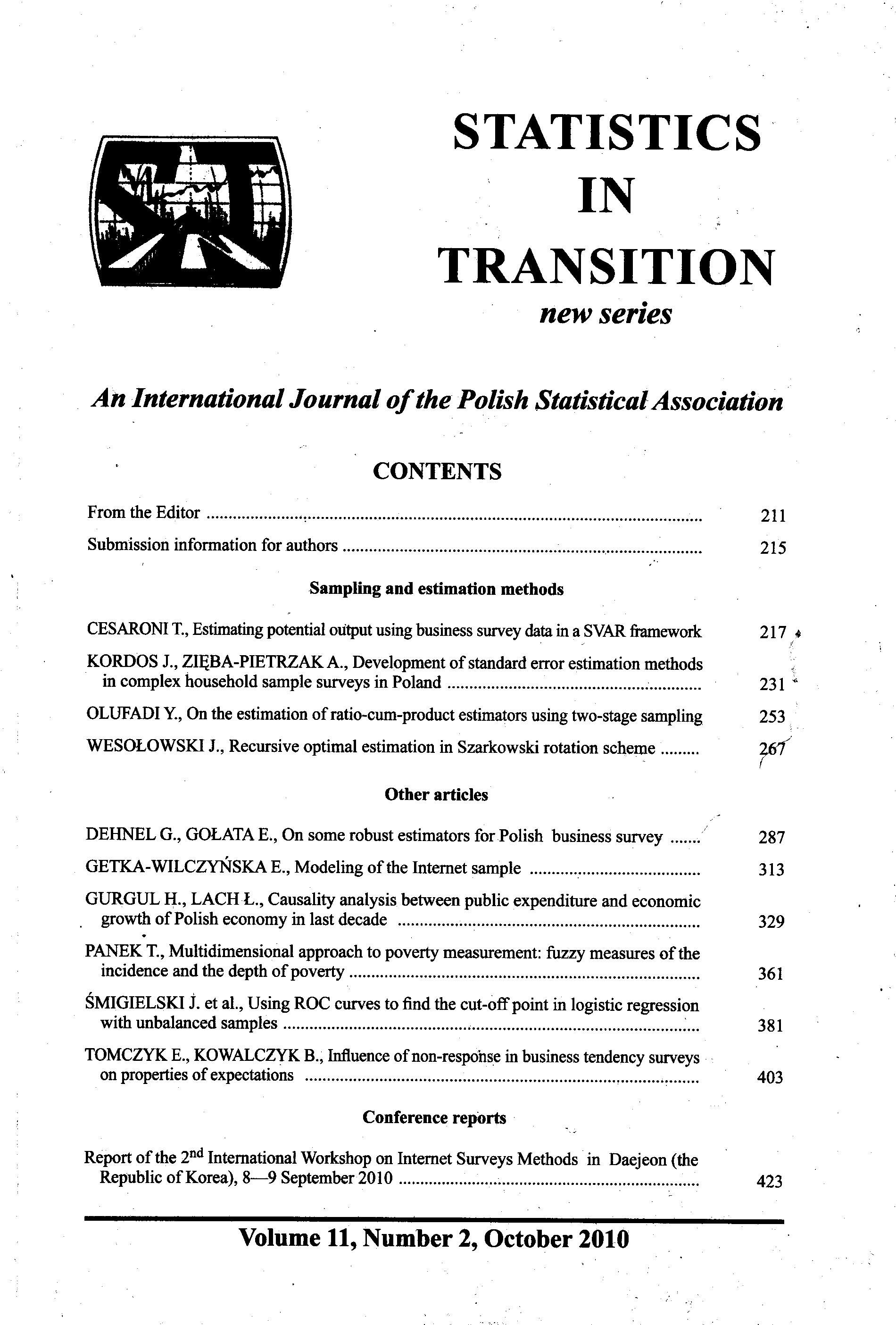ARTICLE
ABSTRACT
The paper presents a methodology for study of multi-dimensional aspects of poverty. In addition to the traditional uni-dimensional measures of poverty, exclusively estimated on the basis of the monetary variable (income or expenditure), other non-monetary variables are incorporated in analysis of the poverty phenomenon. The multidimensional approach has been based on the fuzzy sets theory in which the conventional poor/non-poor dichotomy is replaced by assessment of the degree of household poverty threat. The same methodology facilitates comprehensive monetary and non-monetary poverty analysis. In order to provide effective assessment of poverty the fuzzy measures of poverty were applied. The study employs the fuzzy measures to compare the degree of monetary poverty and deprivation threat in Polish voivodships in 2007 using micro data from the EU-SILC survey. The results of estimation of the fuzzy measures show that poverty in Poland has many dimensions and that its measurement solely from income standing vantage point is highly insufficient.
KEYWORDS
multi-dimensional poverty, fuzzy poverty measures, aggregation of indicators.
REFERENCES
ABEL-SMITH B., TOWNSEND P. (1973): The Poor and the Poorest, in: Atkinson A. B. (eds.) Wealth, Income and Inequality, Penguin Education, Harmondsworth.
ATKINSON A. B. AND BOURGUIGNON F. (1982): The Comparison of Multidimensional Distribution of Economic Status, Review of Economic Studies, 49: 183–201.
BETTI G., CHELI B., LEMMI A. AND VERMA V. (2006): Multidimensional and Longitudinal Poverty: An Integrated Fuzzy Approach, in: Lemmi A. and Bett G. (eds) Fuzzy Set Approach to Multidimensional Poverty Measurement, 111–137, Springer, New York.
BETTI G., VERMA V. (1999): Measuring the Degree of Poverty in a Dynamic and Comparative Context: A Multi-dimensional Approach Using Fuzzy Set Theory, Proceedings, ICCS-VI, Vol. 11: 289–301, Lahore, Pakistan, August 27–31, 1999.
BETTI G., VERMA V. (2008): Fuzzy Measures of the Incidence of Relative Poverty and Deprivation: a Multi-dimensional Perspective, Statistical Methods and Applications,17: 225–250.
BOURGUIGNON F. AND CHAKRAVARTY S. R. (2003): The Measurement of Multidimensional Poverty, Journal of Economic Inequality, 1: 25–49.
CENTRAL STATISTICAL OFFICE (2009): Incomes and Living Conditions of the Population in Poland. Report from the EU-SILC Survey of 2007 and 2008, Warsaw.
CERIOLI A., ZANI S. (1990): A fuzzy approach to the measurement of poverty, in: Dagum C. and Zenga M. (eds): Income and wealth distribution, inequality and poverty, 272–284, Springer Verlag, Berlin.
CHELI B., LEMMI A. (1995): A Totally Fuzzy and Relative Approach to the Multidimensional Analysis of Poverty, Economic Notes, 24: 115–134.
DESAI M., SHAH A. (1988): An Econometric Approach to the Measurement of Poverty, Oxford Economic Papers, 40(3), 505–522.
DEUTSCH, J., SILBER, J. (2005): Measuring Multidimensional Poverty: An Empirical Comparison of Various Approaches, Review of Income and Wealth, 51(1): 145–74.
Fuzzy Set Approach to Multidimensional Poverty Measurement (2006): Lemmi A. and Betti G. (eds), Springer, New York.
HAGENAARS A. J. M. (1986): The Perception of Poverty, North Holland, Amsterdam.
MARSHALL A. (1920): Principles of Economics, 8th ed., Macmillan, London.
MCCARTHY P. J., SNOWDEN C. B. (1985): The Bootstrap and Finite Population Sampling, Vital and Health Statistics, 2(95), U.S. Government Printing Office, Washington.
PANEK T. (1996): A Multidimensional Analysis of the Poverty in Poland in 1995 and 1996, Statistics in Transition, (3)5: 979–1002.
PANEK T. (2009): Poverty Indices in Multidimensional Approach, Wiadomości Statystyczne (in Polish), 12: 1–19.
SEN A. K. (1999): Development as Freedom, Oxford University Press, Oxford.
TOWNSEND P. (1979): Poverty in the United Kingdom, Penguin Books, Middlesex.
TSUI K. Y. (2002): Multidimensional Poverty Indices, Social Choice and Welfare, 19(1): 69–93.
WHELAN C. T., LAYTE R., MAITRE B., NOLAN B. (2001): Income, Deprivation and Economic Strain: An Analysis of the European Community Household Panel, European Sociological Review, 17: 357–372.
ZADEH L. A. (1965): Fuzzy Sets, Information and Control, 8: 338–353.
